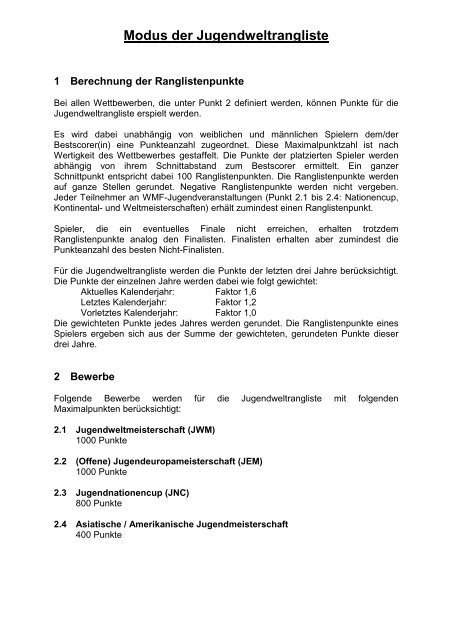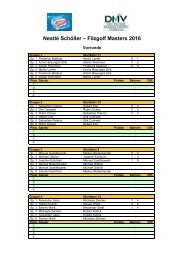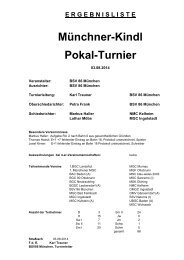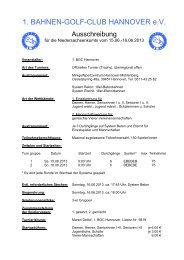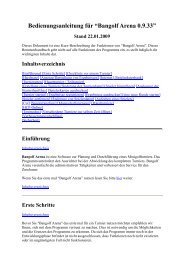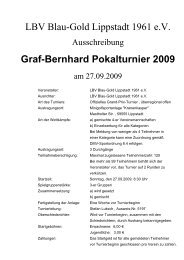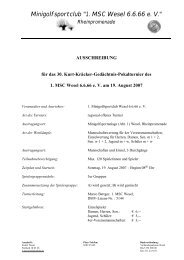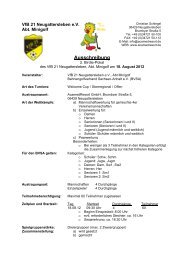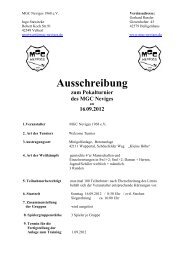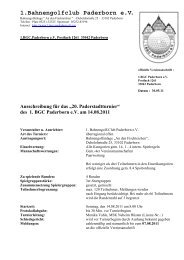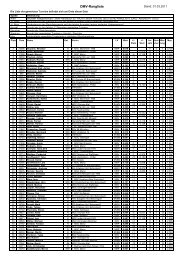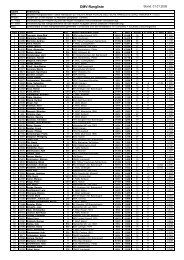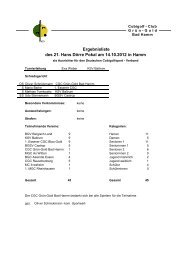Modus der Jugendweltrangliste - Deutscher Minigolfsport Verband
Modus der Jugendweltrangliste - Deutscher Minigolfsport Verband
Modus der Jugendweltrangliste - Deutscher Minigolfsport Verband
Create successful ePaper yourself
Turn your PDF publications into a flip-book with our unique Google optimized e-Paper software.
<strong>Modus</strong> <strong>der</strong> <strong>Jugendweltrangliste</strong><br />
1 Berechnung <strong>der</strong> Ranglistenpunkte<br />
Bei allen Wettbewerben, die unter Punkt 2 definiert werden, können Punkte für die<br />
<strong>Jugendweltrangliste</strong> erspielt werden.<br />
Es wird dabei unabhängig von weiblichen und männlichen Spielern dem/<strong>der</strong><br />
Bestscorer(in) eine Punkteanzahl zugeordnet. Diese Maximalpunktzahl ist nach<br />
Wertigkeit des Wettbewerbes gestaffelt. Die Punkte <strong>der</strong> platzierten Spieler werden<br />
abhängig von ihrem Schnittabstand zum Bestscorer ermittelt. Ein ganzer<br />
Schnittpunkt entspricht dabei 100 Ranglistenpunkten. Die Ranglistenpunkte werden<br />
auf ganze Stellen gerundet. Negative Ranglistenpunkte werden nicht vergeben.<br />
Je<strong>der</strong> Teilnehmer an WMF-Jugendveranstaltungen (Punkt 2.1 bis 2.4: Nationencup,<br />
Kontinental- und Weltmeisterschaften) erhält zumindest einen Ranglistenpunkt.<br />
Spieler, die ein eventuelles Finale nicht erreichen, erhalten trotzdem<br />
Ranglistenpunkte analog den Finalisten. Finalisten erhalten aber zumindest die<br />
Punkteanzahl des besten Nicht-Finalisten.<br />
Für die <strong>Jugendweltrangliste</strong> werden die Punkte <strong>der</strong> letzten drei Jahre berücksichtigt.<br />
Die Punkte <strong>der</strong> einzelnen Jahre werden dabei wie folgt gewichtet:<br />
Aktuelles Kalen<strong>der</strong>jahr: Faktor 1,6<br />
Letztes Kalen<strong>der</strong>jahr: Faktor 1,2<br />
Vorletztes Kalen<strong>der</strong>jahr: Faktor 1,0<br />
Die gewichteten Punkte jedes Jahres werden gerundet. Die Ranglistenpunkte eines<br />
Spielers ergeben sich aus <strong>der</strong> Summe <strong>der</strong> gewichteten, gerundeten Punkte dieser<br />
drei Jahre.<br />
2 Bewerbe<br />
Folgende Bewerbe werden für die <strong>Jugendweltrangliste</strong> mit folgenden<br />
Maximalpunkten berücksichtigt:<br />
2.1 Jugendweltmeisterschaft (JWM)<br />
1000 Punkte<br />
2.2 (Offene) Jugendeuropameisterschaft (JEM)<br />
1000 Punkte<br />
2.3 Jugendnationencup (JNC)<br />
800 Punkte<br />
2.4 Asiatische / Amerikanische Jugendmeisterschaft<br />
400 Punkte
<strong>Modus</strong> <strong>der</strong> <strong>Jugendweltrangliste</strong><br />
2.5 Sonstige Bewerbe<br />
300 Punkte<br />
Neben allen WMF-Veranstaltungen <strong>der</strong> allgemeinen Klasse (Nationencup,<br />
Kontinental- und Weltmeisterschaft, Europacup) können auf Antrag an die<br />
WMF-Jugendkommission auch offizielle Jugendlän<strong>der</strong>kämpfe in die<br />
<strong>Jugendweltrangliste</strong> aufgenommen werden. Es müssen dabei aber mindestens<br />
5 Jugend-Spieler am Start sein. Bei mehreren Bewerben wird pro Spieler und<br />
Jahr nur die beste Wertung in die Rangliste übernommen.<br />
2.6 Nationale Jugendmeisterschaften<br />
Für die Berechnung <strong>der</strong> Maximalpunktzahl einer nationalen<br />
Jugendmeisterschaft wird eine Reihung <strong>der</strong> WMF-Nationen vorgenommen. Die<br />
Reihung basiert auf <strong>der</strong> zum November veröffentlichten Rangliste und ergibt<br />
sich aus <strong>der</strong> Summe <strong>der</strong> Ranglistenpunkte aller Spieler/innen je<strong>der</strong> Nation. Die<br />
Maximalpunktzahl bei den nationalen Meisterschaften <strong>der</strong> besten Nation beträgt<br />
500 Punkte. Die Maximalpunktzahl <strong>der</strong> weiteren Nationen wird aufgrund <strong>der</strong>en<br />
Reihung jeweils um 20 Punkte reduziert. Dies bedeutet, dass z.B. für die<br />
zweitgereihte Nation 480 Maximalpunkte, für die drittgereihte Nation 460<br />
Maximalpunkte, usw. vergeben werden. Mindestens werden jedoch 100<br />
Maximalpunkte für eine nationale Meisterschaft vergeben.<br />
Es erhalten maximal die 10 besten weiblichen bzw. die 20 besten männlichen<br />
Spieler einer nationalen Meisterschaft Ranglistenpunkte. Finden in einer Nation<br />
mehrere nationale Jugend-Meisterschaften statt, entscheidet <strong>der</strong><br />
Nationalverband, welche Meisterschaft er für die Jugend-Weltrangliste meldet.<br />
Die Ergebnisse <strong>der</strong> nationalen Jugendmeisterschaften sind durch die Nationalverbände<br />
bis spätestens zur JEM / JWM mittels Formular und einer Kopie <strong>der</strong><br />
Originalergebnisliste an die WMF-Jugendkommission zu melden.<br />
3 Veröffentlichung<br />
Die <strong>Jugendweltrangliste</strong> wird zweimal jährlich herausgegeben. Termine sind <strong>der</strong><br />
März und <strong>der</strong> November jeden Jahres.<br />
Bei <strong>der</strong> im März veröffentlichten <strong>Jugendweltrangliste</strong> werden alle Spieler, die bei <strong>der</strong><br />
JEM o<strong>der</strong> JWM im Sommer altersbedingt nicht mehr spielberechtigt sind, aus <strong>der</strong><br />
Rangliste herausgenommen. Für die verbleibenden Spieler werden die<br />
Ranglistenpunkte neu berechnet. Es werden dabei die bisher erreichten Punkte <strong>der</strong><br />
beiden letzten Jahre neu gewichtet.<br />
Die offizielle Veröffentlichung <strong>der</strong> <strong>Jugendweltrangliste</strong> erfolgt auf <strong>der</strong> Homepage <strong>der</strong><br />
WMF.
Mode of world-ranking-list for juniors<br />
1 Calculation of ranking-points<br />
Players can get points for the world-ranking-list at all competitions, which are listed in<br />
point 2.<br />
For the best result of a tournament (independent if boy or girl) players get a defined<br />
number of points. This maximum points depends on the level of tournament. The<br />
points for the players behind the bestscore are calculated by the round-difference to<br />
the bestscore. 1,00 round-difference is 100 ranking-points. The ranking-points will be<br />
rounded. Negative ranking points are not calculated. Each participant of WMF-Youth-<br />
Competitions (points 2.1 to 2.4: Nationscup, Continental- and World-Championships)<br />
gets at least 1 point for the ranking-list.<br />
Player, who don’t reach a final, get also ranking-points in the same way as the<br />
finalists. Finalists get at least so many points as the best not-qualified player.<br />
For the world ranking-list will be integrated the points of the last 3 years with different<br />
factors.<br />
Actual year factor 1,6<br />
Last year factor 1,2<br />
The year before last year factor 1,0<br />
The points, which are calculated with factors will be rounded each year. The rankingpoints<br />
of one player are the sum of the rounded points of three years.<br />
2 Competitions<br />
The following maximum points players can get at tournaments:<br />
2.1 Youth-World-Championship (YWC)<br />
1000 points<br />
2.2 Open Youth-European-Championship (YEC)<br />
1000 points<br />
2.3 Youth-Nationscup (YNC)<br />
800 points<br />
2.4 Asian / American Youth-Championship<br />
400 points<br />
2.5 Other Competitions<br />
300 points<br />
Additional to all WMF-competitions for adults (Nationscup, Continental- and<br />
World-Championships, European Cup) official competitions between youthnational-teams<br />
can also be integrated in the ranking list through motion to the<br />
WMF-youth-committee. It is necessary, that at least 5 junior players take part at<br />
these competitions. If there are more competitions there will be integrated in the<br />
ranking list only the best result per player and year.
Mode of world-ranking-list for juniors<br />
2.6 National Championships<br />
For the calculation of the maximum points of a national youth-championship the<br />
nations were listed in a row. The ranking of the nations is based at the rankinglist<br />
of November and depends on the sum of the ranking-list-points of all players<br />
(boys and girls) of each nation. The maximum points at the national<br />
championships of the best nation is 500. The maximum points of the other<br />
nations will be reduced by 20 points each according to the nation-ranking. That<br />
means the second nation will get 480 points for the best result at their national<br />
championship, the third 460 and so on. All nations get at least 100 maximum<br />
points for their national championship.<br />
Only the first 20 boys or 10 girls of a national championship can be ranked for<br />
the world-ranking-list.<br />
If there are different national championships in one nation, the nation decides,<br />
which championship they will announce to the world-ranking-list.<br />
The results of the national championships are announced latest at the YEC or<br />
YWC by an official form and the official result-list to the WMF-youth-committee.<br />
3 Publication<br />
The world-ranking list will be published two times a year. Dates are March and<br />
November of each year.<br />
The edition from march will exclude all players, who are not allowed by age-reason to<br />
play the next youth-championship. The points of the remaining players will be<br />
calculated new. Therefore the former points of the last two years will be calculated<br />
with the new factors.<br />
The official world-ranking list will be published by internet at the homepage of WMF.


